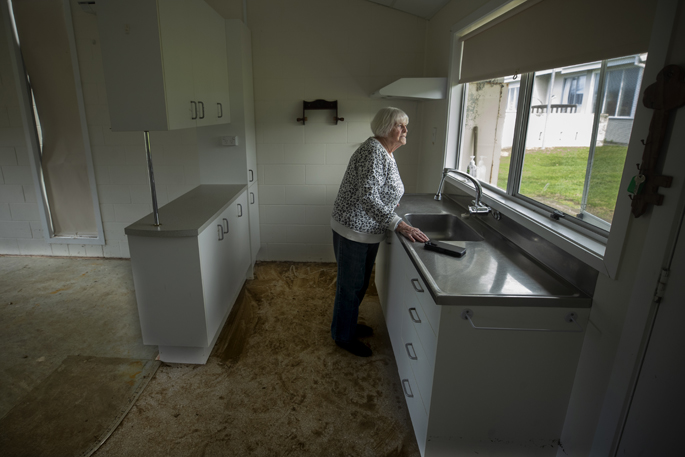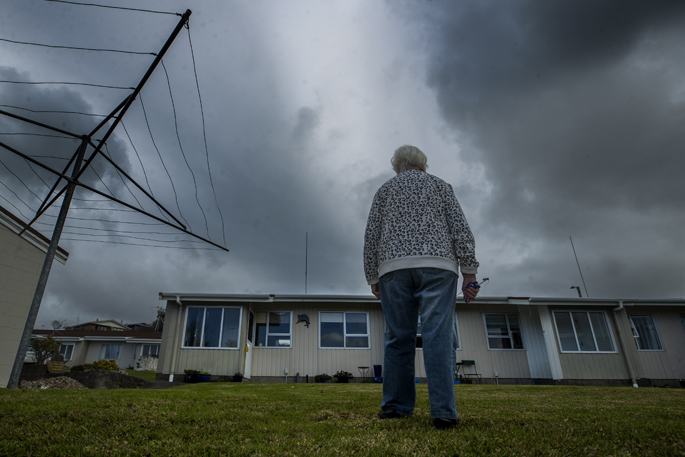Flash floods ripped through the seaside town of Waihī Beach on May 29.
Twenty-seven people were evacuated including residents from eleven council owned elder housing units on Beach Road.
The water swiftly rose to window height forcing them to flee and leave behind treasured possessions.
Two families were also evacuated from the local holiday park.
Western Bay of Plenty District Council admits the stormwater network simply didn’t have the capacity to deal with the amount of rain that fell that day.
Waihī Beach Community Board chair Ross Goudie says, in his view, “something fundamentally went wrong”.
What did happen that Monday in May? This two part series by Local Democracy Reporter Alisha Evans will look at how the floods have affected people’s livelihoods and how the council is responding.
The council recorded 67mm of rain between 1pm and 2.30pm and a total of 91.4mm on May 29.
The town’s dam overflowed into the emergency spillway for 40 minutes from 1.26pm.
Goudie says had the floods happened at night “we may have lost somebody in the [pensioner] flats”.
“They'd have been asleep and the water would've been up around their beds … up to the window tops and in the dark no one knows what's going on.”
 Phoebe Hansen says she wouldn’t like to return home unless something is done about the drainage. Photo: John Borren/SunLive.
Phoebe Hansen says she wouldn’t like to return home unless something is done about the drainage. Photo: John Borren/SunLive.
Pensioner Phoebe Hansen describes the wall of water, that forced her to evacuate her home of 27 years, as Niagara Falls.
“It came in under the door so quickly. I started to put towels down, which was a waste because next minute it came flying over the wall and through one door and right through and out the other.”
By the time she was rescued by the fire service the water was at hip height and she couldn’t walk against the current.
“It was a bit frightening because it happened so quickly and you couldn't react to it all.”
It’s also not the first time Hansen has been displaced by flooding. In 2012 the flats were flooded after a “weather bomb” hit the town causing the creeks and dam level to rise.
“That was different. It [water] seeped under the door and went all through, but it gave you time to lift everything.”
Sitting in the self-contained flat council found for her while she waits to move home, the 85-year-old is stoic in her recollection of events.
She describes her current situation as being “up in limbo” and says it is a bit lonely.
“I belong to different clubs and I go to that, but it's not the same as just walking to get your mail and chatting to two or three people on the way.”
 Water rose to window height in the front seven pensioner units on Beach Road. Photo: Susan Lean/Supplied.
Water rose to window height in the front seven pensioner units on Beach Road. Photo: Susan Lean/Supplied.
Hansen was also uninsured and lost all her furniture and appliances, but says the community are “looking after” her and offered her a fridge and bed.
The pensioner is in two minds about returning home. “I really want to go back into my own place. I wouldn't like to go back if they don't do anything about the drainage.”
After the 2012 incident, whenever she heard rain she would worry it was going to be another flood.
“I couldn't live with that again. I wouldn't like to go through it all again.”
The council found homes for all of its displaced tenants. Nine are housed locally in self-contained accommodation and one is in permanent accommodation at a nearby care facility to assist with their ongoing needs.
“We know it’s tough for them to be out of their homes, but we need to ensure that they have a safe, healthy home to return to,” says WBOPDC Waihī Beach stormwater project leader James Abraham.
The extra rental costs come to $2706 per fortnight for nine people and is covered by insurance, he says.
The council has quotes to repair the four least affected units, which includes Hansen’s, says Abraham.
Once these quotes are approved by the insurer the contractors are ready to go, he says.
Asked if these would be raised to prevent future flooding, Abraham replied: “These units are being repaired, as they hadn't been flooded before the 29 May floods.”
Hansen confirmed she lived in the same unit for 27 years and has been flooded twice.
“The other seven units are more vulnerable to flooding and need some extra consideration,” says Abraham.
 Mud and debris remain in Phoebe Hansen’s home two months after the flood. Photo: John Borren/SunLive.
Mud and debris remain in Phoebe Hansen’s home two months after the flood. Photo: John Borren/SunLive.
The council is “shifting away” from their current “level of service” to protect homes in a 1 in 100 year flooding event to “looking at how to protect life in those situations,” he says.
New research from Australia enables flood hazard risks to be assessed through what speed and depth of water would cause risk to life, he says.
Asked if the council should have shifted the focus to protecting life after the 2012 flood, Abraham replied: “I couldn’t comment on that”.
After seeing the effects of the May 29 flood, Abraham says he thought the new research should be applied.
“Our level of service is protecting homes, but is that enough? We have an obligation to the community to ensure things are safe.”
Goudie says, in his view, the council should have opened the dam valve as per their protocol.
“If the dam had been lowered [and] the bottom valve had been open, it would've been much more capacity running down the stream so that it wouldn't have got up that high,” he claimed.
Abraham says the dam, built in 1963, was originally a water reservoir and not designed for stormwater storage.
In instances of heavy rain warnings “typically our [the council’s] process has been to lower that dam,” he says.
 The Waihī Beach dam was built in 1963 to store water for town supply. Photo: John Borren/SunLive.
The Waihī Beach dam was built in 1963 to store water for town supply. Photo: John Borren/SunLive.
Had it been lowered it would’ve provided an extra 10 minutes of capacity before overflowing, says Abraham.
“I'm not going to sit here and say that 10 minutes wasn't worth it, because 10 minutes is better than nothing.”
The flood gate “has a tendency to get stuck” when opened and the dam takes around two hours to drain, he says.
“If we had opened it and it did get stuck on that day, the effects would've been worse.
“Although that isn't the reason why it wasn't open that day, one of the main reasons was we [the council] didn't get that heavy rain forewarning.”
The council didn't receive an official rain warning for Waihī Beach, Tauranga or the Coromandel, so it didn't trigger the council's pre-rain checks of the dam and stormwater system, but one was carried out on May 18, he says.
The council deferred planned upgrades to the dam because it was waiting for new legislation on dam safety guidelines that came out in 2022. There is a project in the council’s long-term plan to address the issues, which has now been “brought forward as a priority”, says Abraham.
 Waihī Beach Community Board chair Ross Goudie. Photo: John Borren/SunLive.
Waihī Beach Community Board chair Ross Goudie. Photo: John Borren/SunLive.
Goudie says the council and community have to understand exactly what happened to avoid the same thing in future.
“We need to make certain that when we do get a large amount of water, which will come again in the next five to 10 years there is less impact.”
The council have formed a community liaison group with Waihī Beach community board members, the mayor and three councillors, hapū representatives and members of the Stormwater Action Team, that formed in 2013 in response to the first flood.
They held their first meeting last week to discuss the $19 million in stormwater upgrades planned to take place over the next few years.
Abraham says: “We've definitely heard what the community is saying, and completely understand when events like this come through, it's devastating, which is why we're reprioritising projects and reassessing if our current levels of service are correct.”
Next week – Is the area indefensible against future flooding?
Public Interest Journalism funded through NZ On Air.




0 comments
Leave a Comment
You must be logged in to make a comment.